Critical appraisal of an article using the CASP tool
VerifiedAdded on 2023/06/13
|9
|2490
|277
AI Summary
This article provides a critical appraisal of an article using the CASP tool. The study design was a pragmatic one that was based on a randomized controlled trial, with the aim of evaluating the effects of nurse practitioner service. The article analyses the trial on the basis of various parameters such as randomisation, allocation of patients, blinding, treatment effect, and generalisation of results.
Contribute Materials
Your contribution can guide someone’s learning journey. Share your
documents today.
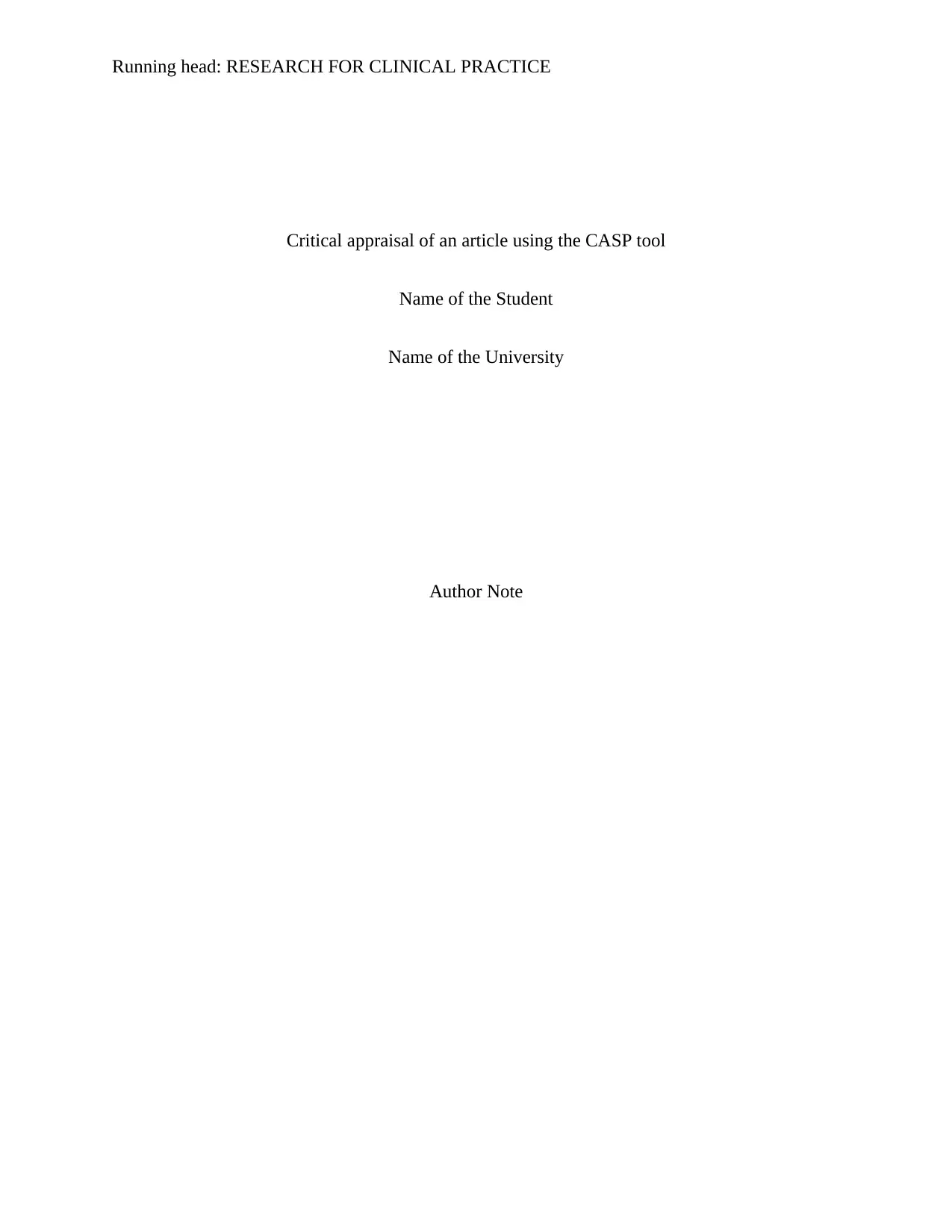
Running head: RESEARCH FOR CLINICAL PRACTICE
Critical appraisal of an article using the CASP tool
Name of the Student
Name of the University
Author Note
Critical appraisal of an article using the CASP tool
Name of the Student
Name of the University
Author Note
Secure Best Marks with AI Grader
Need help grading? Try our AI Grader for instant feedback on your assignments.

1RESEARCH FOR CLINICAL PRACTICE
Article analysed:
Jennings, N., Gardner, G., O'reilly, G. and Mitra, B., 2015. Evaluating emergency nurse
practitioner service effectiveness on achieving timely analgesia: a pragmatic randomized
controlled trial. Academic Emergency Medicine, 22(6), pp.676-684.
1. Did the trial address a clearly focused issue? Yes Can’t tell No
2. Was the assignment of the patients to treatment randomized? Yes Can’t tell No
Randomisation refers to the process of randomly allocating individuals or sample for a
particular research activity or across particular intervention or treatment groups (Hróbjartsson et
al. 2014). The study design was a pragmatic one that was based on a randomized controlled trial,
with the aim of evaluating the effects of nurse practitioner service. The patients who presented
symptoms related to pain were randomly assigned in the research study in two different groups
namely, standard ED medical care and NP care. Randomisation of 260 patients resulted in
allotment of 128 patients to the standard care group, and 130 to the NP care group. Use of a
computer random number generator facilitated the process of random sampling and helped in
removing selection bias between the two different patient groups.
Concealed allocation encompasses the procedure that is often implemented in
randomized controlled trials, which involves blinding of individuals who screen and separate the
candidates into two or more groups (Pocock 2013). The primary investigators who played an
essential role in data analysis were blinded to the intervention allocation. There was no mention
of concealing the sequence from the patients or the researchers. The researches indicated that
Article analysed:
Jennings, N., Gardner, G., O'reilly, G. and Mitra, B., 2015. Evaluating emergency nurse
practitioner service effectiveness on achieving timely analgesia: a pragmatic randomized
controlled trial. Academic Emergency Medicine, 22(6), pp.676-684.
1. Did the trial address a clearly focused issue? Yes Can’t tell No
2. Was the assignment of the patients to treatment randomized? Yes Can’t tell No
Randomisation refers to the process of randomly allocating individuals or sample for a
particular research activity or across particular intervention or treatment groups (Hróbjartsson et
al. 2014). The study design was a pragmatic one that was based on a randomized controlled trial,
with the aim of evaluating the effects of nurse practitioner service. The patients who presented
symptoms related to pain were randomly assigned in the research study in two different groups
namely, standard ED medical care and NP care. Randomisation of 260 patients resulted in
allotment of 128 patients to the standard care group, and 130 to the NP care group. Use of a
computer random number generator facilitated the process of random sampling and helped in
removing selection bias between the two different patient groups.
Concealed allocation encompasses the procedure that is often implemented in
randomized controlled trials, which involves blinding of individuals who screen and separate the
candidates into two or more groups (Pocock 2013). The primary investigators who played an
essential role in data analysis were blinded to the intervention allocation. There was no mention
of concealing the sequence from the patients or the researchers. The researches indicated that
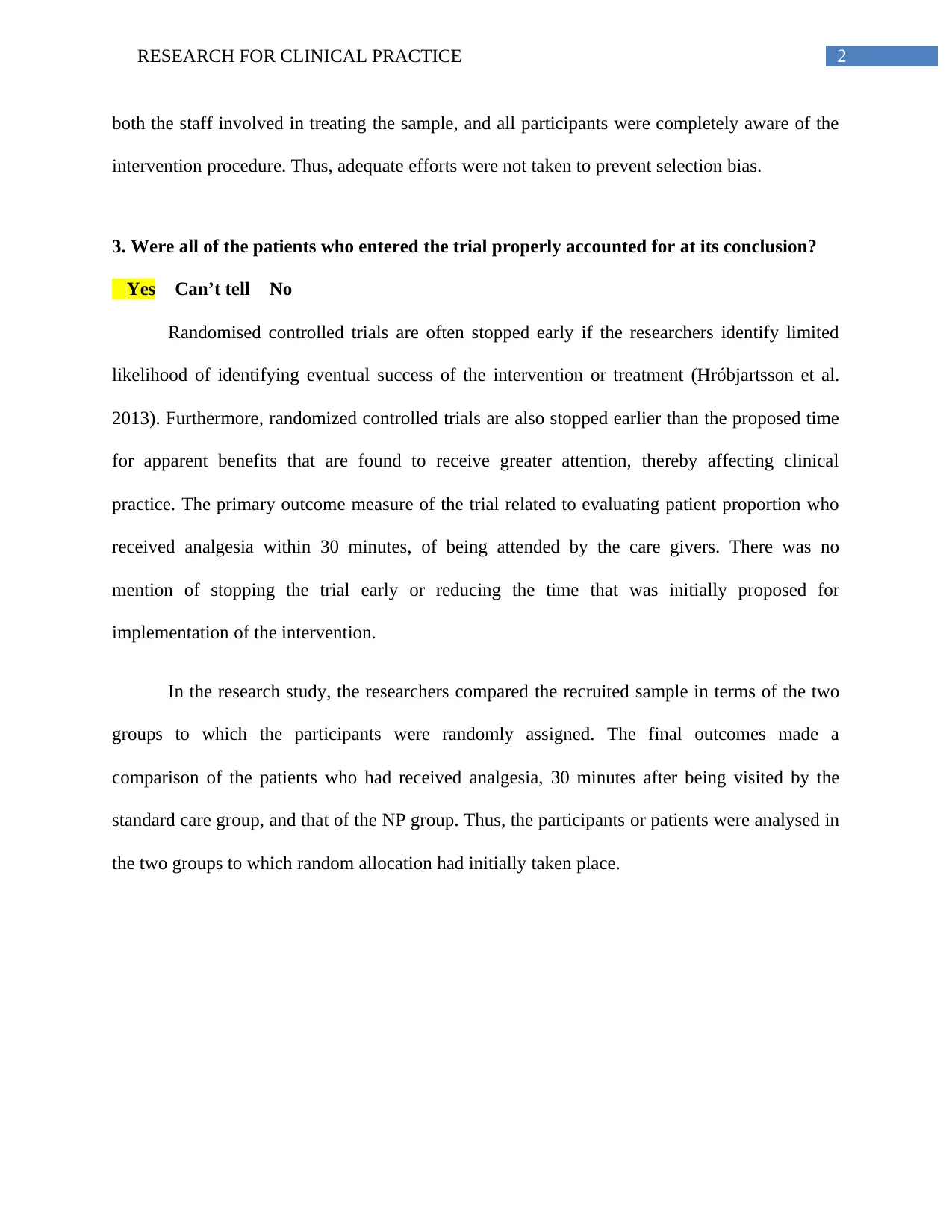
2RESEARCH FOR CLINICAL PRACTICE
both the staff involved in treating the sample, and all participants were completely aware of the
intervention procedure. Thus, adequate efforts were not taken to prevent selection bias.
3. Were all of the patients who entered the trial properly accounted for at its conclusion?
Yes Can’t tell No
Randomised controlled trials are often stopped early if the researchers identify limited
likelihood of identifying eventual success of the intervention or treatment (Hróbjartsson et al.
2013). Furthermore, randomized controlled trials are also stopped earlier than the proposed time
for apparent benefits that are found to receive greater attention, thereby affecting clinical
practice. The primary outcome measure of the trial related to evaluating patient proportion who
received analgesia within 30 minutes, of being attended by the care givers. There was no
mention of stopping the trial early or reducing the time that was initially proposed for
implementation of the intervention.
In the research study, the researchers compared the recruited sample in terms of the two
groups to which the participants were randomly assigned. The final outcomes made a
comparison of the patients who had received analgesia, 30 minutes after being visited by the
standard care group, and that of the NP group. Thus, the participants or patients were analysed in
the two groups to which random allocation had initially taken place.
both the staff involved in treating the sample, and all participants were completely aware of the
intervention procedure. Thus, adequate efforts were not taken to prevent selection bias.
3. Were all of the patients who entered the trial properly accounted for at its conclusion?
Yes Can’t tell No
Randomised controlled trials are often stopped early if the researchers identify limited
likelihood of identifying eventual success of the intervention or treatment (Hróbjartsson et al.
2013). Furthermore, randomized controlled trials are also stopped earlier than the proposed time
for apparent benefits that are found to receive greater attention, thereby affecting clinical
practice. The primary outcome measure of the trial related to evaluating patient proportion who
received analgesia within 30 minutes, of being attended by the care givers. There was no
mention of stopping the trial early or reducing the time that was initially proposed for
implementation of the intervention.
In the research study, the researchers compared the recruited sample in terms of the two
groups to which the participants were randomly assigned. The final outcomes made a
comparison of the patients who had received analgesia, 30 minutes after being visited by the
standard care group, and that of the NP group. Thus, the participants or patients were analysed in
the two groups to which random allocation had initially taken place.
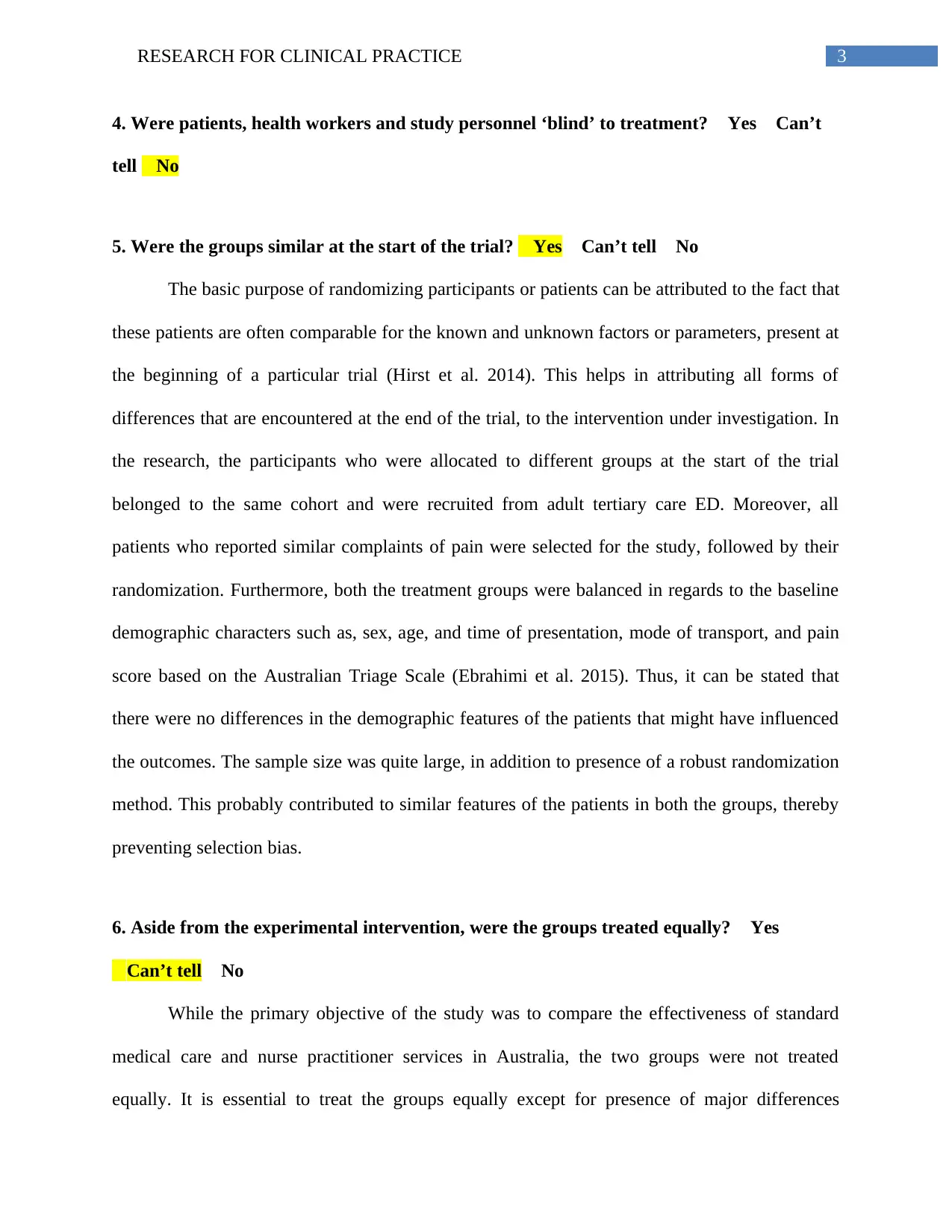
3RESEARCH FOR CLINICAL PRACTICE
4. Were patients, health workers and study personnel ‘blind’ to treatment? Yes Can’t
tell No
5. Were the groups similar at the start of the trial? Yes Can’t tell No
The basic purpose of randomizing participants or patients can be attributed to the fact that
these patients are often comparable for the known and unknown factors or parameters, present at
the beginning of a particular trial (Hirst et al. 2014). This helps in attributing all forms of
differences that are encountered at the end of the trial, to the intervention under investigation. In
the research, the participants who were allocated to different groups at the start of the trial
belonged to the same cohort and were recruited from adult tertiary care ED. Moreover, all
patients who reported similar complaints of pain were selected for the study, followed by their
randomization. Furthermore, both the treatment groups were balanced in regards to the baseline
demographic characters such as, sex, age, and time of presentation, mode of transport, and pain
score based on the Australian Triage Scale (Ebrahimi et al. 2015). Thus, it can be stated that
there were no differences in the demographic features of the patients that might have influenced
the outcomes. The sample size was quite large, in addition to presence of a robust randomization
method. This probably contributed to similar features of the patients in both the groups, thereby
preventing selection bias.
6. Aside from the experimental intervention, were the groups treated equally? Yes
Can’t tell No
While the primary objective of the study was to compare the effectiveness of standard
medical care and nurse practitioner services in Australia, the two groups were not treated
equally. It is essential to treat the groups equally except for presence of major differences
4. Were patients, health workers and study personnel ‘blind’ to treatment? Yes Can’t
tell No
5. Were the groups similar at the start of the trial? Yes Can’t tell No
The basic purpose of randomizing participants or patients can be attributed to the fact that
these patients are often comparable for the known and unknown factors or parameters, present at
the beginning of a particular trial (Hirst et al. 2014). This helps in attributing all forms of
differences that are encountered at the end of the trial, to the intervention under investigation. In
the research, the participants who were allocated to different groups at the start of the trial
belonged to the same cohort and were recruited from adult tertiary care ED. Moreover, all
patients who reported similar complaints of pain were selected for the study, followed by their
randomization. Furthermore, both the treatment groups were balanced in regards to the baseline
demographic characters such as, sex, age, and time of presentation, mode of transport, and pain
score based on the Australian Triage Scale (Ebrahimi et al. 2015). Thus, it can be stated that
there were no differences in the demographic features of the patients that might have influenced
the outcomes. The sample size was quite large, in addition to presence of a robust randomization
method. This probably contributed to similar features of the patients in both the groups, thereby
preventing selection bias.
6. Aside from the experimental intervention, were the groups treated equally? Yes
Can’t tell No
While the primary objective of the study was to compare the effectiveness of standard
medical care and nurse practitioner services in Australia, the two groups were not treated
equally. It is essential to treat the groups equally except for presence of major differences
Secure Best Marks with AI Grader
Need help grading? Try our AI Grader for instant feedback on your assignments.
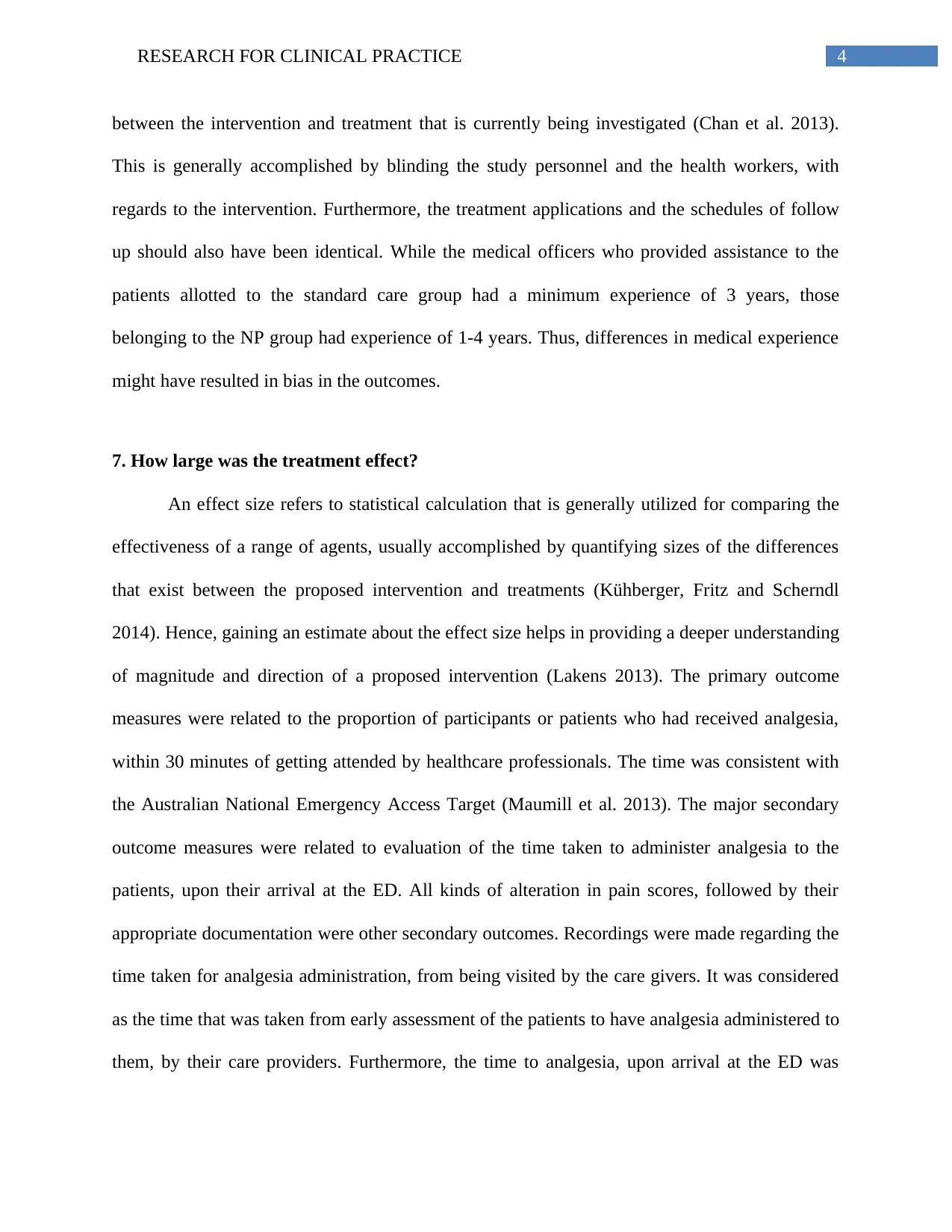
4RESEARCH FOR CLINICAL PRACTICE
between the intervention and treatment that is currently being investigated (Chan et al. 2013).
This is generally accomplished by blinding the study personnel and the health workers, with
regards to the intervention. Furthermore, the treatment applications and the schedules of follow
up should also have been identical. While the medical officers who provided assistance to the
patients allotted to the standard care group had a minimum experience of 3 years, those
belonging to the NP group had experience of 1-4 years. Thus, differences in medical experience
might have resulted in bias in the outcomes.
7. How large was the treatment effect?
An effect size refers to statistical calculation that is generally utilized for comparing the
effectiveness of a range of agents, usually accomplished by quantifying sizes of the differences
that exist between the proposed intervention and treatments (Kühberger, Fritz and Scherndl
2014). Hence, gaining an estimate about the effect size helps in providing a deeper understanding
of magnitude and direction of a proposed intervention (Lakens 2013). The primary outcome
measures were related to the proportion of participants or patients who had received analgesia,
within 30 minutes of getting attended by healthcare professionals. The time was consistent with
the Australian National Emergency Access Target (Maumill et al. 2013). The major secondary
outcome measures were related to evaluation of the time taken to administer analgesia to the
patients, upon their arrival at the ED. All kinds of alteration in pain scores, followed by their
appropriate documentation were other secondary outcomes. Recordings were made regarding the
time taken for analgesia administration, from being visited by the care givers. It was considered
as the time that was taken from early assessment of the patients to have analgesia administered to
them, by their care providers. Furthermore, the time to analgesia, upon arrival at the ED was
between the intervention and treatment that is currently being investigated (Chan et al. 2013).
This is generally accomplished by blinding the study personnel and the health workers, with
regards to the intervention. Furthermore, the treatment applications and the schedules of follow
up should also have been identical. While the medical officers who provided assistance to the
patients allotted to the standard care group had a minimum experience of 3 years, those
belonging to the NP group had experience of 1-4 years. Thus, differences in medical experience
might have resulted in bias in the outcomes.
7. How large was the treatment effect?
An effect size refers to statistical calculation that is generally utilized for comparing the
effectiveness of a range of agents, usually accomplished by quantifying sizes of the differences
that exist between the proposed intervention and treatments (Kühberger, Fritz and Scherndl
2014). Hence, gaining an estimate about the effect size helps in providing a deeper understanding
of magnitude and direction of a proposed intervention (Lakens 2013). The primary outcome
measures were related to the proportion of participants or patients who had received analgesia,
within 30 minutes of getting attended by healthcare professionals. The time was consistent with
the Australian National Emergency Access Target (Maumill et al. 2013). The major secondary
outcome measures were related to evaluation of the time taken to administer analgesia to the
patients, upon their arrival at the ED. All kinds of alteration in pain scores, followed by their
appropriate documentation were other secondary outcomes. Recordings were made regarding the
time taken for analgesia administration, from being visited by the care givers. It was considered
as the time that was taken from early assessment of the patients to have analgesia administered to
them, by their care providers. Furthermore, the time to analgesia, upon arrival at the ED was
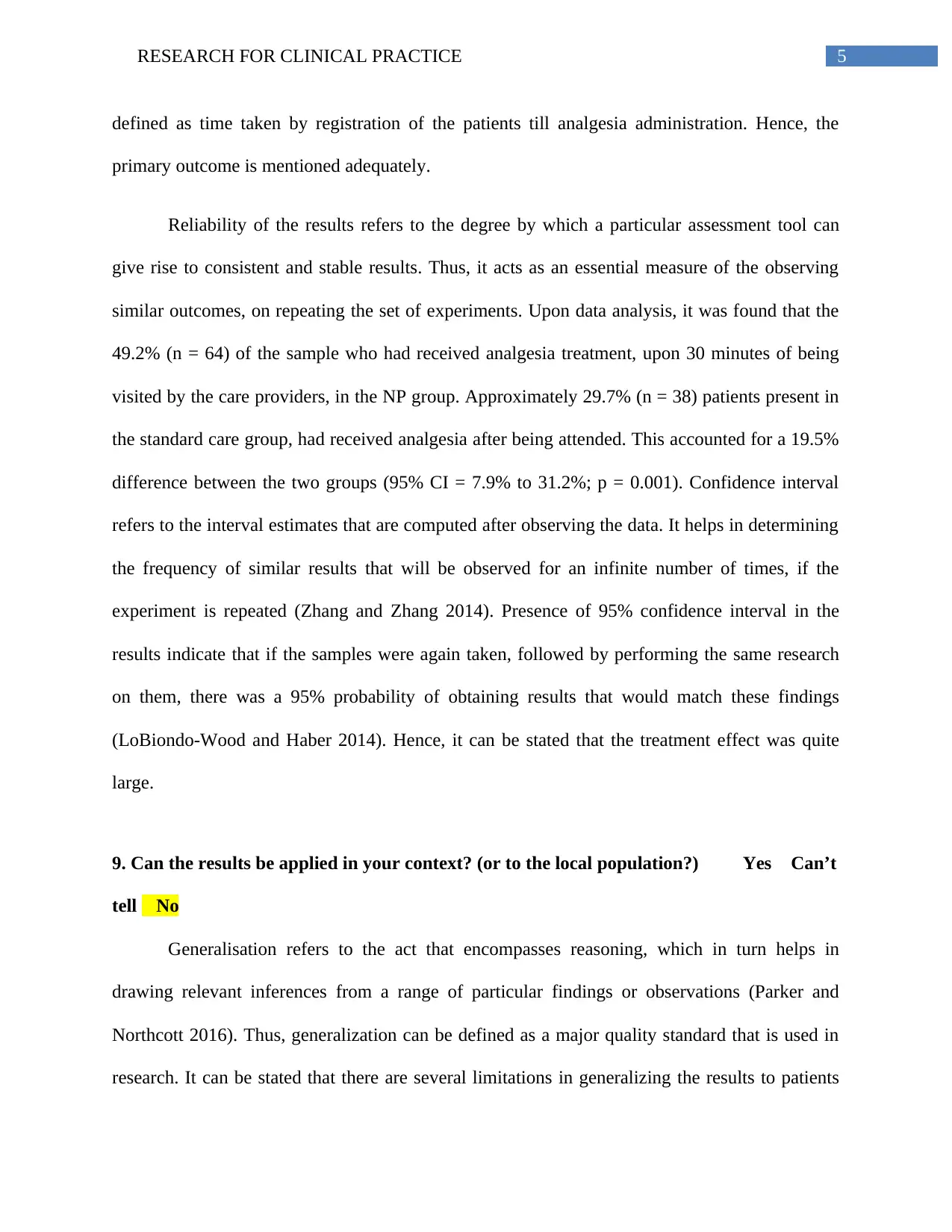
5RESEARCH FOR CLINICAL PRACTICE
defined as time taken by registration of the patients till analgesia administration. Hence, the
primary outcome is mentioned adequately.
Reliability of the results refers to the degree by which a particular assessment tool can
give rise to consistent and stable results. Thus, it acts as an essential measure of the observing
similar outcomes, on repeating the set of experiments. Upon data analysis, it was found that the
49.2% (n = 64) of the sample who had received analgesia treatment, upon 30 minutes of being
visited by the care providers, in the NP group. Approximately 29.7% (n = 38) patients present in
the standard care group, had received analgesia after being attended. This accounted for a 19.5%
difference between the two groups (95% CI = 7.9% to 31.2%; p = 0.001). Confidence interval
refers to the interval estimates that are computed after observing the data. It helps in determining
the frequency of similar results that will be observed for an infinite number of times, if the
experiment is repeated (Zhang and Zhang 2014). Presence of 95% confidence interval in the
results indicate that if the samples were again taken, followed by performing the same research
on them, there was a 95% probability of obtaining results that would match these findings
(LoBiondo-Wood and Haber 2014). Hence, it can be stated that the treatment effect was quite
large.
9. Can the results be applied in your context? (or to the local population?) Yes Can’t
tell No
Generalisation refers to the act that encompasses reasoning, which in turn helps in
drawing relevant inferences from a range of particular findings or observations (Parker and
Northcott 2016). Thus, generalization can be defined as a major quality standard that is used in
research. It can be stated that there are several limitations in generalizing the results to patients
defined as time taken by registration of the patients till analgesia administration. Hence, the
primary outcome is mentioned adequately.
Reliability of the results refers to the degree by which a particular assessment tool can
give rise to consistent and stable results. Thus, it acts as an essential measure of the observing
similar outcomes, on repeating the set of experiments. Upon data analysis, it was found that the
49.2% (n = 64) of the sample who had received analgesia treatment, upon 30 minutes of being
visited by the care providers, in the NP group. Approximately 29.7% (n = 38) patients present in
the standard care group, had received analgesia after being attended. This accounted for a 19.5%
difference between the two groups (95% CI = 7.9% to 31.2%; p = 0.001). Confidence interval
refers to the interval estimates that are computed after observing the data. It helps in determining
the frequency of similar results that will be observed for an infinite number of times, if the
experiment is repeated (Zhang and Zhang 2014). Presence of 95% confidence interval in the
results indicate that if the samples were again taken, followed by performing the same research
on them, there was a 95% probability of obtaining results that would match these findings
(LoBiondo-Wood and Haber 2014). Hence, it can be stated that the treatment effect was quite
large.
9. Can the results be applied in your context? (or to the local population?) Yes Can’t
tell No
Generalisation refers to the act that encompasses reasoning, which in turn helps in
drawing relevant inferences from a range of particular findings or observations (Parker and
Northcott 2016). Thus, generalization can be defined as a major quality standard that is used in
research. It can be stated that there are several limitations in generalizing the results to patients
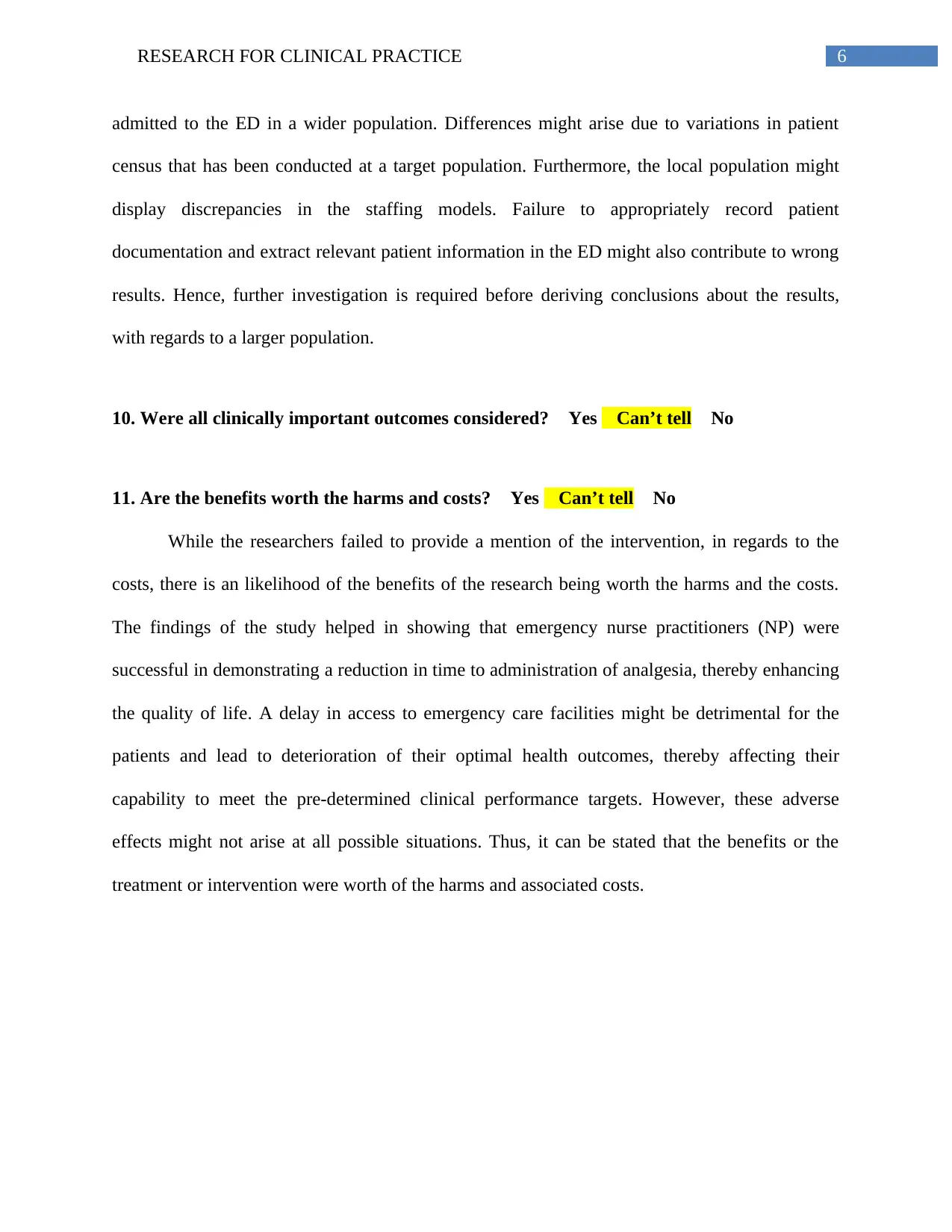
6RESEARCH FOR CLINICAL PRACTICE
admitted to the ED in a wider population. Differences might arise due to variations in patient
census that has been conducted at a target population. Furthermore, the local population might
display discrepancies in the staffing models. Failure to appropriately record patient
documentation and extract relevant patient information in the ED might also contribute to wrong
results. Hence, further investigation is required before deriving conclusions about the results,
with regards to a larger population.
10. Were all clinically important outcomes considered? Yes Can’t tell No
11. Are the benefits worth the harms and costs? Yes Can’t tell No
While the researchers failed to provide a mention of the intervention, in regards to the
costs, there is an likelihood of the benefits of the research being worth the harms and the costs.
The findings of the study helped in showing that emergency nurse practitioners (NP) were
successful in demonstrating a reduction in time to administration of analgesia, thereby enhancing
the quality of life. A delay in access to emergency care facilities might be detrimental for the
patients and lead to deterioration of their optimal health outcomes, thereby affecting their
capability to meet the pre-determined clinical performance targets. However, these adverse
effects might not arise at all possible situations. Thus, it can be stated that the benefits or the
treatment or intervention were worth of the harms and associated costs.
admitted to the ED in a wider population. Differences might arise due to variations in patient
census that has been conducted at a target population. Furthermore, the local population might
display discrepancies in the staffing models. Failure to appropriately record patient
documentation and extract relevant patient information in the ED might also contribute to wrong
results. Hence, further investigation is required before deriving conclusions about the results,
with regards to a larger population.
10. Were all clinically important outcomes considered? Yes Can’t tell No
11. Are the benefits worth the harms and costs? Yes Can’t tell No
While the researchers failed to provide a mention of the intervention, in regards to the
costs, there is an likelihood of the benefits of the research being worth the harms and the costs.
The findings of the study helped in showing that emergency nurse practitioners (NP) were
successful in demonstrating a reduction in time to administration of analgesia, thereby enhancing
the quality of life. A delay in access to emergency care facilities might be detrimental for the
patients and lead to deterioration of their optimal health outcomes, thereby affecting their
capability to meet the pre-determined clinical performance targets. However, these adverse
effects might not arise at all possible situations. Thus, it can be stated that the benefits or the
treatment or intervention were worth of the harms and associated costs.
Paraphrase This Document
Need a fresh take? Get an instant paraphrase of this document with our AI Paraphraser
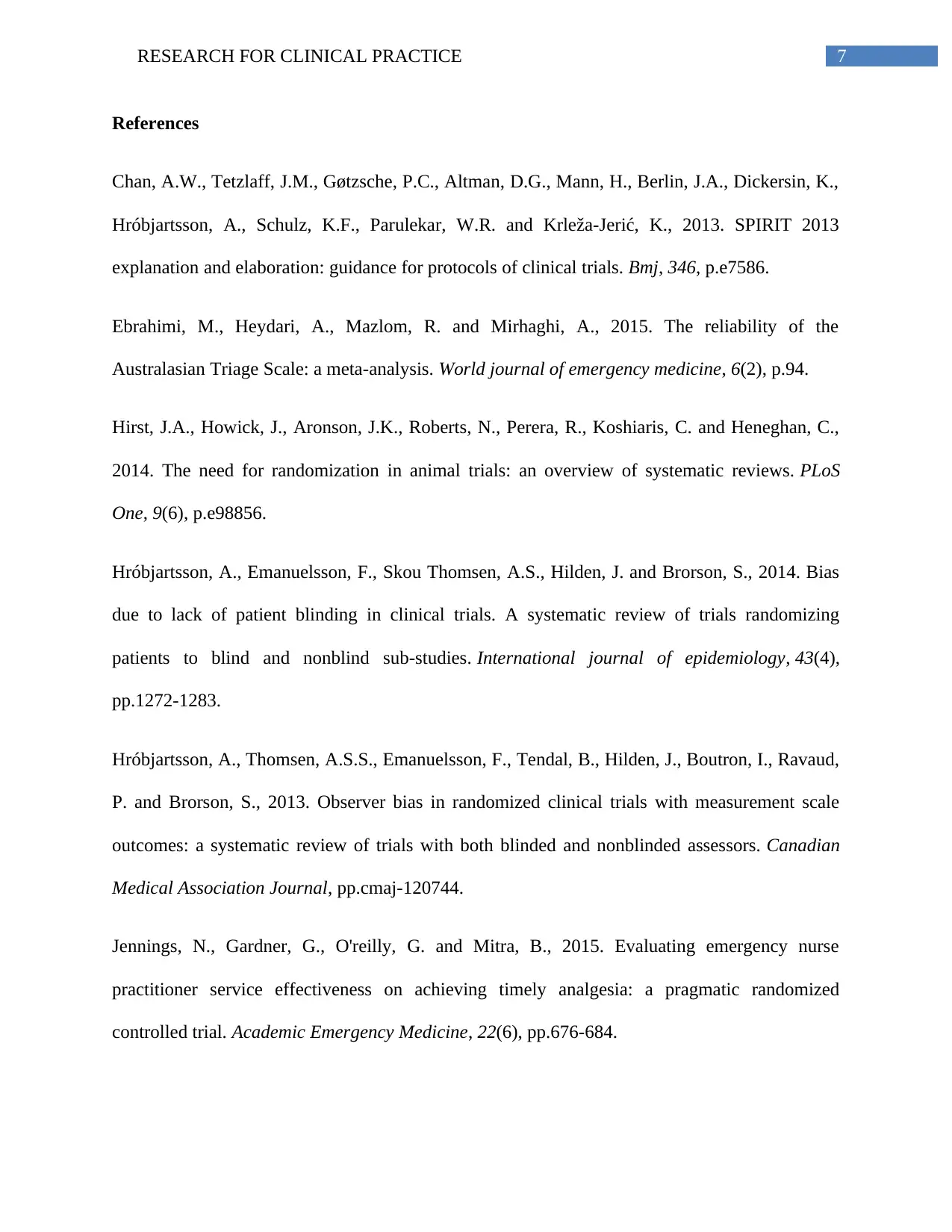
7RESEARCH FOR CLINICAL PRACTICE
References
Chan, A.W., Tetzlaff, J.M., Gøtzsche, P.C., Altman, D.G., Mann, H., Berlin, J.A., Dickersin, K.,
Hróbjartsson, A., Schulz, K.F., Parulekar, W.R. and Krleža-Jerić, K., 2013. SPIRIT 2013
explanation and elaboration: guidance for protocols of clinical trials. Bmj, 346, p.e7586.
Ebrahimi, M., Heydari, A., Mazlom, R. and Mirhaghi, A., 2015. The reliability of the
Australasian Triage Scale: a meta-analysis. World journal of emergency medicine, 6(2), p.94.
Hirst, J.A., Howick, J., Aronson, J.K., Roberts, N., Perera, R., Koshiaris, C. and Heneghan, C.,
2014. The need for randomization in animal trials: an overview of systematic reviews. PLoS
One, 9(6), p.e98856.
Hróbjartsson, A., Emanuelsson, F., Skou Thomsen, A.S., Hilden, J. and Brorson, S., 2014. Bias
due to lack of patient blinding in clinical trials. A systematic review of trials randomizing
patients to blind and nonblind sub-studies. International journal of epidemiology, 43(4),
pp.1272-1283.
Hróbjartsson, A., Thomsen, A.S.S., Emanuelsson, F., Tendal, B., Hilden, J., Boutron, I., Ravaud,
P. and Brorson, S., 2013. Observer bias in randomized clinical trials with measurement scale
outcomes: a systematic review of trials with both blinded and nonblinded assessors. Canadian
Medical Association Journal, pp.cmaj-120744.
Jennings, N., Gardner, G., O'reilly, G. and Mitra, B., 2015. Evaluating emergency nurse
practitioner service effectiveness on achieving timely analgesia: a pragmatic randomized
controlled trial. Academic Emergency Medicine, 22(6), pp.676-684.
References
Chan, A.W., Tetzlaff, J.M., Gøtzsche, P.C., Altman, D.G., Mann, H., Berlin, J.A., Dickersin, K.,
Hróbjartsson, A., Schulz, K.F., Parulekar, W.R. and Krleža-Jerić, K., 2013. SPIRIT 2013
explanation and elaboration: guidance for protocols of clinical trials. Bmj, 346, p.e7586.
Ebrahimi, M., Heydari, A., Mazlom, R. and Mirhaghi, A., 2015. The reliability of the
Australasian Triage Scale: a meta-analysis. World journal of emergency medicine, 6(2), p.94.
Hirst, J.A., Howick, J., Aronson, J.K., Roberts, N., Perera, R., Koshiaris, C. and Heneghan, C.,
2014. The need for randomization in animal trials: an overview of systematic reviews. PLoS
One, 9(6), p.e98856.
Hróbjartsson, A., Emanuelsson, F., Skou Thomsen, A.S., Hilden, J. and Brorson, S., 2014. Bias
due to lack of patient blinding in clinical trials. A systematic review of trials randomizing
patients to blind and nonblind sub-studies. International journal of epidemiology, 43(4),
pp.1272-1283.
Hróbjartsson, A., Thomsen, A.S.S., Emanuelsson, F., Tendal, B., Hilden, J., Boutron, I., Ravaud,
P. and Brorson, S., 2013. Observer bias in randomized clinical trials with measurement scale
outcomes: a systematic review of trials with both blinded and nonblinded assessors. Canadian
Medical Association Journal, pp.cmaj-120744.
Jennings, N., Gardner, G., O'reilly, G. and Mitra, B., 2015. Evaluating emergency nurse
practitioner service effectiveness on achieving timely analgesia: a pragmatic randomized
controlled trial. Academic Emergency Medicine, 22(6), pp.676-684.
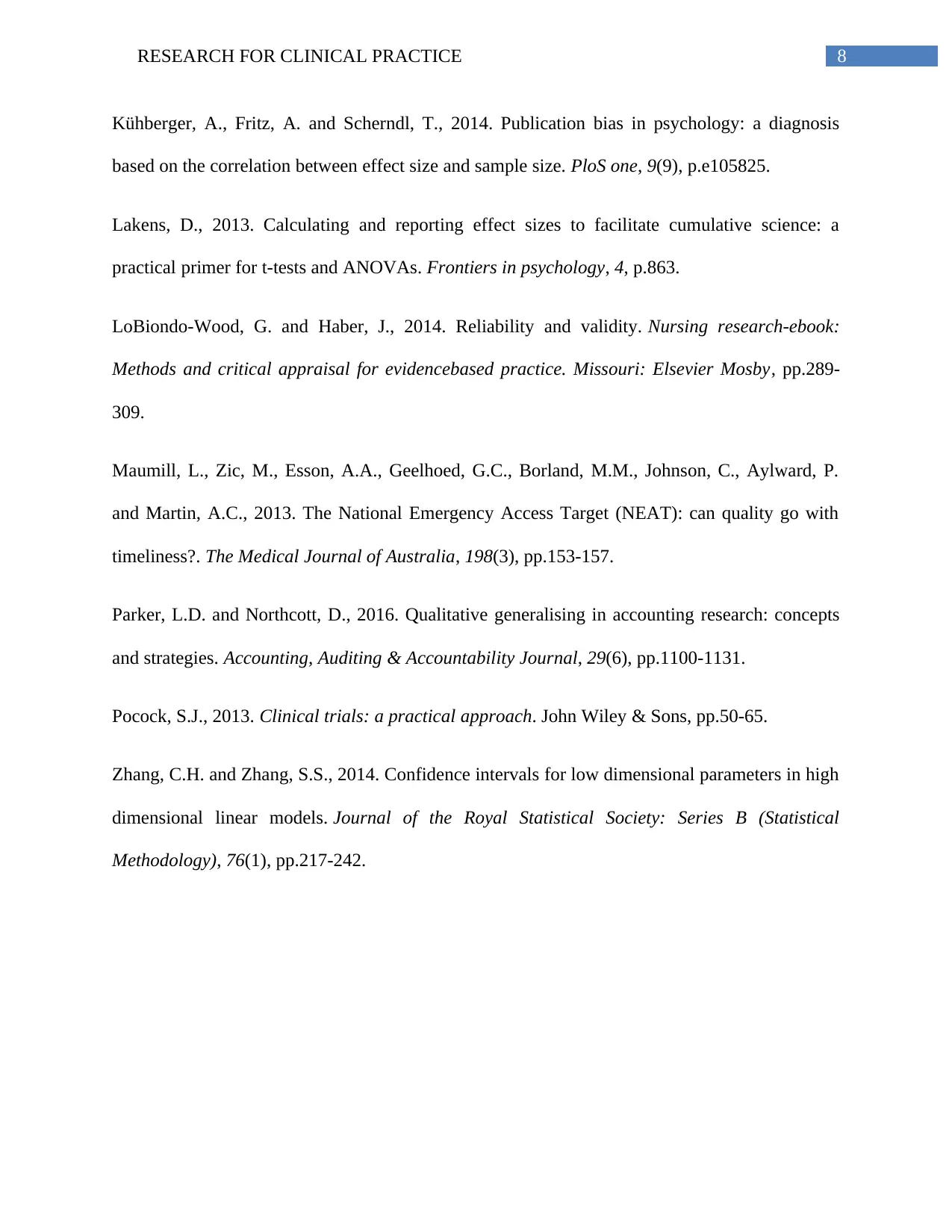
8RESEARCH FOR CLINICAL PRACTICE
Kühberger, A., Fritz, A. and Scherndl, T., 2014. Publication bias in psychology: a diagnosis
based on the correlation between effect size and sample size. PloS one, 9(9), p.e105825.
Lakens, D., 2013. Calculating and reporting effect sizes to facilitate cumulative science: a
practical primer for t-tests and ANOVAs. Frontiers in psychology, 4, p.863.
LoBiondo-Wood, G. and Haber, J., 2014. Reliability and validity. Nursing research-ebook:
Methods and critical appraisal for evidencebased practice. Missouri: Elsevier Mosby, pp.289-
309.
Maumill, L., Zic, M., Esson, A.A., Geelhoed, G.C., Borland, M.M., Johnson, C., Aylward, P.
and Martin, A.C., 2013. The National Emergency Access Target (NEAT): can quality go with
timeliness?. The Medical Journal of Australia, 198(3), pp.153-157.
Parker, L.D. and Northcott, D., 2016. Qualitative generalising in accounting research: concepts
and strategies. Accounting, Auditing & Accountability Journal, 29(6), pp.1100-1131.
Pocock, S.J., 2013. Clinical trials: a practical approach. John Wiley & Sons, pp.50-65.
Zhang, C.H. and Zhang, S.S., 2014. Confidence intervals for low dimensional parameters in high
dimensional linear models. Journal of the Royal Statistical Society: Series B (Statistical
Methodology), 76(1), pp.217-242.
Kühberger, A., Fritz, A. and Scherndl, T., 2014. Publication bias in psychology: a diagnosis
based on the correlation between effect size and sample size. PloS one, 9(9), p.e105825.
Lakens, D., 2013. Calculating and reporting effect sizes to facilitate cumulative science: a
practical primer for t-tests and ANOVAs. Frontiers in psychology, 4, p.863.
LoBiondo-Wood, G. and Haber, J., 2014. Reliability and validity. Nursing research-ebook:
Methods and critical appraisal for evidencebased practice. Missouri: Elsevier Mosby, pp.289-
309.
Maumill, L., Zic, M., Esson, A.A., Geelhoed, G.C., Borland, M.M., Johnson, C., Aylward, P.
and Martin, A.C., 2013. The National Emergency Access Target (NEAT): can quality go with
timeliness?. The Medical Journal of Australia, 198(3), pp.153-157.
Parker, L.D. and Northcott, D., 2016. Qualitative generalising in accounting research: concepts
and strategies. Accounting, Auditing & Accountability Journal, 29(6), pp.1100-1131.
Pocock, S.J., 2013. Clinical trials: a practical approach. John Wiley & Sons, pp.50-65.
Zhang, C.H. and Zhang, S.S., 2014. Confidence intervals for low dimensional parameters in high
dimensional linear models. Journal of the Royal Statistical Society: Series B (Statistical
Methodology), 76(1), pp.217-242.
1 out of 9
Related Documents
Your All-in-One AI-Powered Toolkit for Academic Success.
+13062052269
info@desklib.com
Available 24*7 on WhatsApp / Email
![[object Object]](/_next/static/media/star-bottom.7253800d.svg)
Unlock your academic potential
© 2024 | Zucol Services PVT LTD | All rights reserved.





